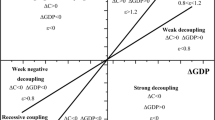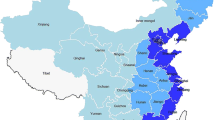Abstract
From now until 2030, China will be in a sprint to achieve reductions of 40–45% in carbon emission intensity by 2020 and 60–65% by 2030 compared to 2005; rigid requirements have thus been imposed for controlling carbon emission intensity. In this study, a spatial Durbin model that integrates a spatial lag model and a spatial error model is used to measure the degree of influence held by the energy consumption structure and other factors over carbon emission intensity and the spatial spillover effect. The results show that there is a spatial demonstration effect on the reduction in interregional carbon emission intensity in China. While the carbon emission intensity in the adjacent region decreases by 1%, the carbon emission intensity in this region will decrease by 0.05%, indicating that China’s regional low-carbon development model is also applicable to neighboring provinces and plays a large role in driving and demonstrating a low-carbon economy. Every additional 1% improvement toward optimizing the energy consumption structure enables the carbon emission intensity of the region to decrease by 0.21%; further, there is a positive spatial spillover effect driving carbon emission intensity decreases in neighboring areas of 0.25%. Industrial structure, energy intensity, energy price, and level of openness are the main factors influencing regional carbon emission intensity. According to the “14th Five-Year Plan,” there is an urgent need to optimize the energy consumption structure in the medium and long term and give full play to its ability to contribute to declines in carbon emission intensity.
Similar content being viewed by others
References
Alves MR, Moutinho V (2013) Decomposition analysis and innovative accounting approach for energy-related CO2, (carbon dioxide) emissions intensity over 1996–2009 in Portugal. Energy 57(3):775–787
Ang BW, Su B (2016) Carbon emission intensity in electricity production: a global analysis. Energy Policy 94:56–63
Anselin L (1987) Spatial econometrics: methods and models. Econ Geogr 65(2):160–162
Anselin L (2001) Spatial effects in econometric practice in environmental and resource economics. Am J Agric Econ 83(3):705–710
Anselin L (2007) Spatial econometrics. A companion to theoretical econometrics. Blackwell Publishing Ltd, Hoboken, pp 310–330
Baltagi BH (2013) Econometric analysis of panel data, 4th edition. Econ Theor (5):747–754
Barnali Nag M (2000) Carbon emission intensity of power consumption in India: a detailed study of its indicators. Energy Sources 22(2):157–166
Bhattacharyya SC, Matsumura W (2010) Changes in the GHG emission intensity in eu-15: lessons from a decomposition analysis. Energy 35(8):3315–3322
Chen S (2011) The abatement of carbon dioxide intensity in China: factors decomposition and policy implications. World Econ 34(7):1148–1167
Chen Y, Lin S (2015) Decomposition and allocation of energy-related carbon dioxide emission allowance over provinces of China. Nat Hazards 76(3):1893–1909
Chik NA, Rahim KA, Radam A, Shamsudin MN (2013) Impact of Malaysian industrial energy use on carbon dioxide emissions. Pertan J Soc Sci Humanit 21:13–28
Cui E, Ren L, Sun H (2016) Analysis of energy-related CO2 emissions and driving factors in five major energy consumption sectors in China. Environ Sci Pollut Res Int 23(19):1–8
Dong F, Long R, Li Z, Dai Y (2016) Analysis of carbon emission intensity, urbanization and energy mix: evidence from China. Nat Hazards 82(2):1375–1391
Du G (2013) Analysis of carbon emission based on stochastic IPAT model. Int J Appl Math Stat™ 47(17):230–238
Ebohon OJ, Ikeme AJ (2006) Decomposition analysis of CO2, emission intensity between oil-producing and non-oil-producing sub-Saharan African countries. Energy Policy 34(18):3599–3611
Elhorst JP (2005) Unconditional maximum likelihood estimation of linear and log-linear dynamic models for spatial panels. Geogr Anal 37(1):85–106
Elhorst JP (2016) Specification and estimation of spatial panel data models. Int Reg Sci Rev 26(3):244–268
Fan F, Lei Y (2016) Decomposition analysis of energy-related carbon emissions from the transportation sector in Beijing. Transp Res Part D 42:135–145
Fan JL, Liao H, Liang QM, Tatano H, Liu CF, Wei YM (2013) Residential carbon emission evolutions in urban–rural divided China: an end-use and behavior analysis. Appl Energy 101(1):323–332
Fang G, Tian L, Fu M, Sun M (2013) The impacts of carbon tax on energy intensity and economic growth—a dynamic evolution analysis on the case of China. Appl Energy 110(5):17–28
Fisher-Vanden K, Schu K, Wing IS, Calvin K (2012) Decomposing the impact of alternative technology sets on future carbon emissions growth. Energy Econ 34(2):S359–S365
Giblin S, Mcnabola A (2009) Modelling the impacts of a carbon emission-differentiated vehicle tax system on co emissions intensity from new vehicle purchases in Ireland. Energy Policy 37(4):1404–1411
Greening LA (2004) Effects of human behavior on aggregate carbon emission intensity of personal transportation: comparison of 10 OECD countries for the period 1970–1993. Energy Econ 26(1):1–30
Greening LA, Davis WB, Schipper L (1998) Decomposition of aggregate carbon emission intensity for the manufacturing sector: comparison of declining trends from 10 OECD countries for the period 1971–1991. Energy Econ 20(97):43–65
Greening LA, Ting M, Davis WB (1999) Decomposition of aggregate carbon emission intensity for freight: trends from 10 OECD countries for the period 1971–1993. Energy Econ 21(4):331–361
Greening LA, Ting M, Krackler TJ (2001) Effects of changes in residential end-uses and behavior on aggregate carbon emission intensity: comparison of 10 OECD countries for the period 1970 through 1993. Energy Econ 23(2):153–178
Hammond GP, Norman JB (2012) Decomposition analysis of energy-related carbon emissions from UK manufacturing. Energy 41(1):220–227
Jiang J (2017) The decomposition and policy meaning of China’s carbon emission intensity. Evolut Inst Econ Rev 14(1):295–310
Jiao J, Yang Y, Bai Y (2018) The impact of inter-industry R&D technology spillover on carbon emission in China. Nat Hazards 91(3):913–929
Jovanović M, Kašćelan L, Despotović A, Kašćelan V (2015) The impact of agro-economic factors on GHG emissions: evidence from european developing and advanced economies. Sustainability 7(12):16290–16310
Köne AÇ, Büke T (2016) The impact of changing energy mix of turkey on CO2 emission intensities. Environ Prot Eng 42(3):85–93
Lee LF, Yu J (2010) Estimation of spatial autoregressive panel data models with fixed effects. J Econ 154(2):165–185
Lessage JP, Pace RK (2009) Introduction to spatial econometrics. CRC Press, Boca Raton. Spatial Demography, 1(1):143–145
Li ZZ (2013) Mining and analyzing energy layout on carbon emission intensities of industrial sectors. Adv Mater Res 807–809:857–860
Li W, Ou QX (2013) Decomposition of China’s carbon emissions intensity from 1995 to 2010: an extended KAYA identity. Math Probl Eng 2013(3):1–7
Li M, Wang Q (2017) Will technology advances alleviate climate change? Dual effects of technology change on aggregate carbon dioxide emissions. Energy Sustain Dev 41:61–68
Lin B, Nelson BI (2017) Influencing factors on carbon emissions in China transport industry. a new evidence from quantile regression analysis. J Clean Prod 150:175–187
Lin B, Omoju OE, Okonkwo JU (2015) Impact of industrialization on CO2 emissions in Nigeria. Renew Sustain Energy Rev 52:1228–1239
Liu SB (2013) Energy consumption and structural reformation in Chinese northeast old industrial base. Appl Mech Mater 448–453:4281–4284
Liu N, Ma Z, Kang J (2015) Changes in carbon emission intensity in China’s industrial sector: decomposition and attribution analysis. Energy Policy 87:28–38
Long R, Yang R, Song M, Ma L (2015) Measurement and calculation of carbon emission intensity based on impact model and scenario analysis: a case of three regions of Jiangsu province. Ecol Ind 51(2):180–190
Lu IJ, Lin SJ, Lewis C (2007) Decomposition and decoupling effects of carbon dioxide emission from highway transportation in Taiwan, Germany, Japan and south Korea. Energy Policy 35(6):3226–3235
Moutinho V, Robaina-Alves M, Mota J (2014) Carbon dioxide emissions intensity of Portuguese industry and energy sectors: a convergence analysis and econometric approach. Renew Sustain Energy Rev 40(C):438–449
Nag B, Parikh J (2000) Indicators of carbon emission intensity from commercial energy use in India. Energy Econ 22(4):441–461
Ohlan R (2015) The impact of population density, energy consumption, economic growth and trade openness on CO2, emissions in India. Nat Hazards 79(2):1–20
Piras G, Elhorst JP, Arbia G (2010) Growth and convergence in a multiregional model with space–time dynamics. Geogr Anal 42(3):338–355
Ren S, Yuan B, Ma X, Chen X (2014) The impact of international trade on China’s industrial carbon emissions since its entry into WTO. Energy Policy 69(3):624–634
Sambodo MT, Oyama T (2011) Investigating economic growth, energy consumption and their impact on CO2 emissions targets in China. J Asian Public Policy 4(3):279–306
Su B, Ang BW (2016) Multi-region comparisons of emission performance: the structural decomposition analysis approach. Ecol Ind 67:78–87
Sun C, Ding D, Yang M (2017) Estimating the complete CO2 emissions and the carbon emission intensity in India: from the carbon transfer perspective. Energy Policy 109:418–427
Tian Y, Xiong S, Ma X, Ji J (2018) Structural path decomposition of carbon emission: a study of China’s manufacturing industry. J Clean Prod 61(480):113–121
Torvanger A (1991) Manufacturing sector carbon dioxide emissions in nine OECD countries, 1973–87: a divisia index decomposition to changes in fuel mix, emission coefficients, industry structure, energy intensities and international structure. Energy Econ 13(3):168–186
Wang J, Ren Y (2013) Dynamic impact of economic development mode transformation on CO2 emission intensity reduction. Int J Appl Environ Sci 8(21):2665–2677
Wang P, Dai HC, Ren SY, Zhao DQ, Masui T (2015) Achieving Copenhagen target through carbon emission trading: economic impacts assessment in Guangdong province of China. Energy 79(79):212–227
Wei P, Zhou Y (2014) Urbanization, energy consumption and carbon emission: a empirical study on transnational panel data based on STIPAT model. Ecol Econ 14(2):571–575
Wen L, Bai L, Zhang E (2016) System dynamic modeling and scenario simulation on Beijing industrial carbon emissions. Environ Eng Res 21(4):355–364
Xu F, Xiang N, Nijkamp P, Higano Y (2013) Dynamic simulation of China’s carbon emission intensity and energy intensity evaluation focusing on industry and energy structure adjustments by 2020. Environ Eng Manag J 12(10):1897–1901
Yu X, Chen H, Wang B, Wang R, Shan Y (2018) Driving forces of CO2 emissions and mitigation strategies of China’s national low carbon pilot industrial parks. Appl Energy 212:1553–1562
Zhang YJ, Da YB (2015) The decomposition of energy-related carbon emission and its decoupling with economic growth in China. Renew Sustain Energy Rev 41:1255–1266
Zhang YJ, Liu Z, Zhang H, Tan TD (2014) The impact of economic growth, industrial structure and urbanization on carbon emission intensity in China. Nat Hazards 73(2):579–595
Zhang W, Li K, Zhou D, Zhang W, Gao H (2016) Decomposition of intensity of energy-related CO2, emission in Chinese provinces using the LMDI method. Energy Policy 92:369–381
Acknowledgements
This research was supported by the National Key R&D Program of China (2016YFA0602601), Special Items Fund of Beijing Municipal Commission of Education of China, Program of Beijing Energy Development Research Center of China (NYJD20170101), and National Social Science Fund of China (15ZDA011).
Author information
Authors and Affiliations
Corresponding author
Additional information
Publisher's Note
Springer Nature remains neutral with regard to jurisdictional claims in published maps and institutional affiliations.
Rights and permissions
About this article
Cite this article
Xiao, H., Ma, Z., Zhang, P. et al. Study of the impact of energy consumption structure on carbon emission intensity in China from the perspective of spatial effects. Nat Hazards 99, 1365–1380 (2019). https://doi.org/10.1007/s11069-018-3535-1
Received:
Accepted:
Published:
Issue Date:
DOI: https://doi.org/10.1007/s11069-018-3535-1




